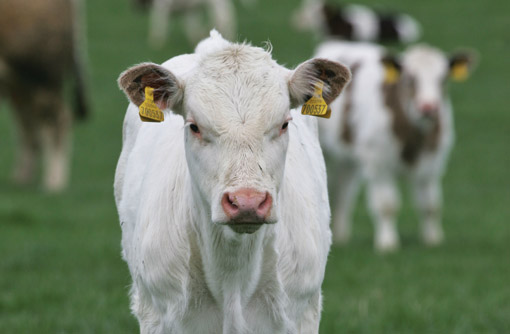Cow and calf nutrition for winter housing

Targeted nutrition for cows and calves helps ensure maximum liveweight gain and health at winter housing. Caroline Stocks reports
Analysing silage to calculate the exact nutritional value of cattle feed has enabled Perthshire farmer David Houstoun to ensure steady weight gain across his herd and help limit disease during winter.
Mr Houstoun, who farms 150 Limousin-cross cattle and 1,050 sheep, runs a spring and autumn calving system that sees about 90 calves born each spring.
In October, 40-45 calves are sold through the local auction market, with the remaining calves housed on the farm alongside replacement heifers.
Keen to create a system of nutrition that works for both younger and older cattle, Mr Houstoun works with Scotland’s Rural College (SRUC) each year to create rations that meet the different nutritional needs of his herd, ensuring steady growth rates until his remaining calves are sold the following spring.
“My system starts by putting creep feed out at the beginning of July to get the calves used to it before we wean them and either sell them or move them inside later in the year,” says Mr Houstoun.
Creep feeding helps reduce the stress of changing diets for calves in winter, as rumens need several weeks to get used to different rations so that micro-organisms inside them can adapt. Managing stress on the calves helps protect them when they are housed against diseases such as scours and pneumonia.
Calves are given a further boost by being vaccinated twice against pneumonia before they are housed or sold, which provides peace of mind for both himself and buyers, Mr Houstoun says.
A week before weaning, all calves are moved on to a creep, silage and straw mix in a further attempt to reduce dietary-related stress.
“This means by the time they are moved or sold at auction – which can be stressful for the animals because they are transported 65 miles to the market and are housed with other cattle – they are used to feeding, ” Mr Houstoun says.
The calves that remain go into bedded areas, while cows go on to slats. Mr Houstoun doesn’t grow any cereals on his hill upland unit, so he brings in a compound feed that is fed to calves from the beginning of July and added to silage in winter.
“The college comes every year to work out our rations based on the quality of our silage.
“They give us two or three options that we follow rigorously to achieve a 0.7 to 1kg a day weight gain. While the heifers get their own diet, the spring calves get straw silage with a syrup that is a by-produce of the local distilleries.
“We weigh the animals every month to six weeks to make sure their growth is on target,” he adds. “By regularly weighing, it gives us time to catch up so that the animals are at the right weight when we turn them out and sell them in spring.
“It’s very important that we monitor the growth of our replacement heifers closely as they calve at two years old.
“Working with the college has been a help to get my nutrition exactly right. “Between us we have developed a system that works for me and my cows.”
Top tips for winter housing nutrition
- Avoid sudden changes in diet when housing stock – ensure a transition period to minimise problems
- Get silage analysed so you know its nutritional value and supplement it if necessary
- Weigh cattle throughout the winter period to ensure liveweight gain is steady and sustained.
Visit the winter health course and take the test
